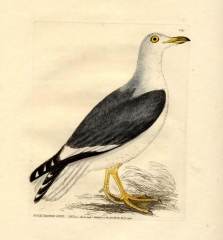
Robust, intelligent, opportunistic and aggressive, the black-backed gull is the only large gull in New Zealand. Although one of the most common and conspicuous birds of our coasts, according to Oliver, it does not appear to have been listed as a New Zealand bird until Gray, in Dieffenbach's Travels in New Zealand in 1843, included it. The Erebus and Terror expedition collected it in the Auckland Islands in 1840 and also recorded it from Mount Egmont.
The black-backed gull is a circumpolar navigator, living in and around the coasts of South America, South Africa, south–east Australia and New Zealand. Being a scavenger by nature, it lives and breeds in a multitude of places, from rocky ledges to open areas of pasture. vetula breeds in South Africa and dominicanus breeds widely in the subantarctic and temperate southern hemisphere.
Unlike most of our native bird life, the black–backed gull has adapted well to European settlement, from taking advantage of an abundant supply of insects and small animals off pasturelands to scavenging off refuse tips in the urban environment and foraging along the coastal front.
Oliver records, that “the food of the black-backed gull consists of all kinds of animal matter. Every kind of animal matter cast up by the waves is greedily devoured, whether fresh or putrified, including the carcasses of whales and seals, dead fish and birds. It feeds largely on bivalve molluscs, breaking the shell by carrying it to some height and dropping it on hard sand or on rock. It also feeds on the eggs and young of birds, especially the terns near which it breeds; and on adult birds it is able to catch; and on grubs and worms which it finds on its inland excursions. Small fishes are caught, sometimes from the surface of the sea and sometimes from tidal pools.”
On farms they invariably turn up at lambing and at calving time to take advantage of dropped afterbirth and any weak or dead animals. Oliver also records the destruction of large numbers of tuatara on Stephen's Island; "a gull waits at a burrow for hours until a tuatara emerges, grabs it and then flies to sea and back to its nest, dropping the lizard every now and then to kill it."
We have been told, says Elsdon Best, that occasionally, the Karoro sea gull was tamed by Maori and employed as a pest–destroyer, released among the sweet potato crops that they might consume the the big caterpillars that infested the plants. One early collector of data tells us that such tame birds would accompany on the wing the people of the village when moving to other parts on a fishing, fowling, rat–catching or berry collecting expedition but another such collector has stated that such birds were deprived of their powers of flight by their captors.
The black–backed gull was once fully protected under the Wildlife act 1953. However this full protection was lifted in 1970.
Greytown, Wairarapa, 2005.

Other common names: —
Southern black–backed gull, dominican gull, kelp gull, laughing gull.
Description: —
Native bird
60 cm., males, 1050g., females 850g., wingspan, 120cm. In the adult, the head, neck, underparts, rump and tail are white, the back and upper wings are black with a narrow white trailing edge; the bill is yellow with a red spot at the tip of the lower bill; the eye is pale yellow and the legs greenish yellow; juveniles are brown; in the second year the back is brown and the breast and neck are white flecked with brown; voice of young is a shrill whistle.
Where to find: —
Widespread along coast and inland.
Poetry: —
Tangi amio ana te karoro i te awa
Nga tohu o te ipo unuhia noatia
The black-backed gulls circle the channel, crying
They are a sign my beloved is taken from me.
— Margaret Orbell, The Natural World of the Maori, 1985
Credit for the photograph: —
Illustration description: —
Gray, G.R., The Genera of Birds, 1844–49.
Lewin, William, Birds of Great Britain, 1794–1801.
Reference(s): —
Heather, B., & Robertson, H., Field Guide to the Birds of New Zealand, 2000.
Oliver, W.R.B., New Zealand Birds, 1955.
Best, Elsdon, Forest Lore of the Maori, 1942.
Page date & version: —
Saturday, 17 May, 2014; ver2009v1

